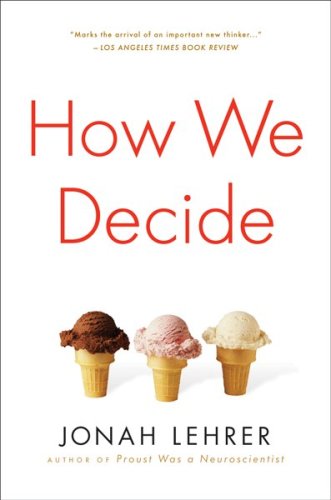I have always been a strong proponent of decision-making as a critical skill in navigating the trial, tribulations and opportunities life presents. In these current turbulent economic and political times, where our brains are pummeled with enormous amounts of data and emotions run high, the skill of decision-making is even more crucial.
However, most decision analysis classes and books reduce the skill to an incredible array of variables, decision trees, probability assignments and sensitivity calculations. These methods make the necessary assumption that everything can be reduced and translated down to numbers and branches of options.
Jonah Lehrer, editor at large of Seed Magazine, takes a refreshing approach in his latest book, ‘How We Decide’. He applies the latest findings of neuroscience to explain, using simple and entertaining stories, how our brain works. The the idea is that if you have a better understanding, you can make better decisions.
But how?
Firstly, Lehrer breaks down the age-old belief that the rational brain and the emotional brain are opposing forces as set out by philosophers from the past, such as Plato, when the mind and how it worked was a complete mystery and black box. New research, Lehrer notes, supports the works of such scientists as William James who in his 1890 textbook, ‘The Principles of Psychology’, claimed the “mind contained two distinct thinking systems, one that was rational and deliberate and another that was quick, effortless, and emotional.” (pg. 26). Examples are brought forth not only from studies in neuroscience, but also everyday observations such as the speed at which Tom Brady makes decisions on the football field, how a pilot chooses among infinite actions during the crucial moments of an emergency landing and how a world-champion poker player beats out the competition.
How We Decide
by Jonah Lehrer
$25, 302 pages, hardcover, Houghton Mifflin Harcourt, New YorkRating:
4.5 out of 5 starsLoni says:
“A critical and refreshing examination into how the rational and emotional parts of the brain work and how we can use both to make better decisions. Trust your gut and read this book.”Where to buy:
Amazon
Secondly, having dispelled the notion that our emotional and rational brains are at war, Lehrer challenges the reader to think about the act of thinking and how we use our emotional and rational brains to arrive at the best decisions.
He illustrates how simple decisions with few variables such as choosing a vegetable peeler should exercise our rational brains whereas complex decisions involving a multitude of factors should be left to our emotional brain. However, it is not as simple as just leaving it to our gut instinct, we must train that gut instinct. We need to do this by practice, making mistakes and doing a post-analysis of why we made the mistake. It is only through this hard and sometimes painful process, Lehrer contends, that we are able, in a moment when it really counts, to be able to trust our gut. He notes that incidents of airplanes crashing plummeted when realistic flight simulators were introduced to the training regime of air pilots.
I thoroughly enjoyed this book and I highly recommend it. This book, along with ‘Stumbling on Happiness’, are absolute must reads if you want to gain a better understanding of yourself and how your decisions impact your life and happiness.
P.S. The only thing I didn’t like about this book was the cover. The three ice cream cones made people think I was reading a book about dieting.


